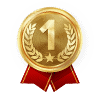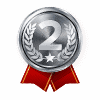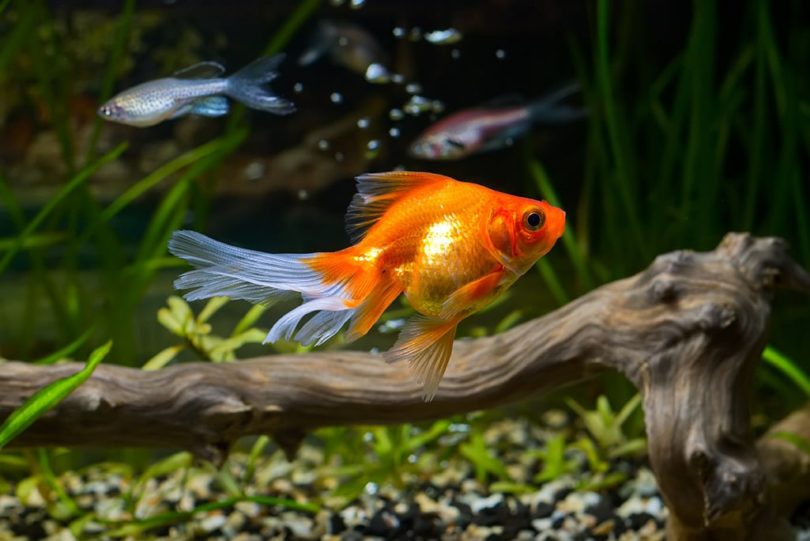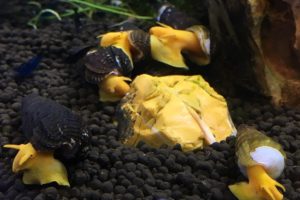
You’ve likely seen some really interesting snails in your local fish store but you have probably read that goldfish will eat snails, so you’ve avoided adding snails to your goldfish tank. If this is the case, you should be pleased to know that there are quite a few snails that make excellent tank mates for goldfish! The best part about snails is that they come in so many colors, shapes, and activity levels that there’s at least one type of snail to suit every tank. Whether you want snails for algae control, breeding, or something different altogether, check out these reviews covering the best snails to pair with your goldfish.
Please note that not all freshwater snails are legal to own or sell in all areas, so check the laws in your area before purchasing a snail.

A Glance at Our Winners in 2024
| Image | Product | Details | ||
|---|---|---|---|---|
 |
Mystery Snails |
|
Check Price | |
 |
Japanese Trapdoor Snails |
|
Check Price | |
 |
Sulawesi Rabbit Snails |
|
Check Price | |
 |
Nerite Snails |
|
Check Price | |
 |
Cappuccino Spike/Black Devil Spike Snails |
|
Check Price |
The 10 Best Snails to Pair With Goldfish
1. Mystery Snails
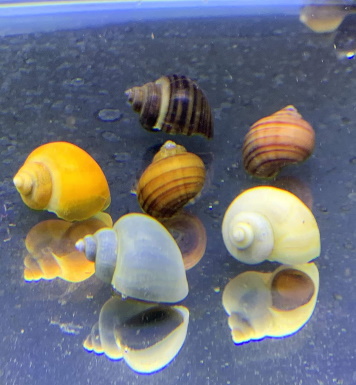
These gentle giants are some of the largest freshwater snails available for home aquariums. Mystery snails are incredibly peaceful and are very active snails, making them fun to watch. They come in multiple solid shell colors, including ivory, magenta, blue, and black. Mystery snails are not hermaphroditic and require a male and a female to reproduce, so you’re unlikely to end up with unwanted egg clutches. If you do end up with eggs, they can easily be scraped out of the tank and frozen before throwing away to prevent development. Mystery snails love to eat and will happily eat snail food, algae wafers, fish food, fruits, veggies, and algae within your tank. They will not eat live plants unless they are dying, but they will eat dead plant matter, helping to keep your tank clean.
Mystery snails are heavy bioload producers for snails, so they should only be kept in well-filtered tanks. Female mystery snails can hold sperm for at least 9 months, so if your female breeds at the pet store, you still may end up with eggs. A single clutch can produce dozens to hundreds of snails.
2. Japanese Trapdoor Snails
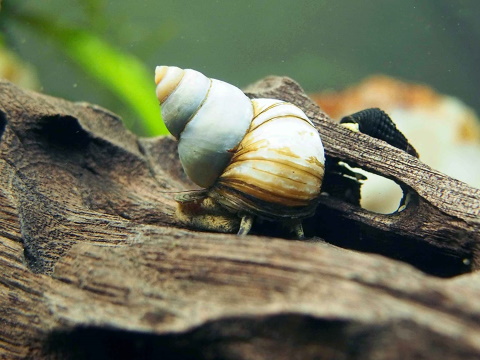
Japanese trapdoor snails are a great pick for a cost-effective type of snail that will work hard to keep your tank clean. They’re available in multiple shell colors that tend to lighten in color the further up the shell you look. They love to eat algae and can happily survive in tanks or ponds, helping to keep things clean wherever they are. They can survive in and improve poor tank conditions, and they can thrive in cooler temperatures than many other snails. Like mystery snails, Japanese trapdoor snails are not hermaphroditic, and they do require a male and female to reproduce. They only breed a couple of times annually and will live-bear 5 to 20 babies per breeding. These snails can live up to 10 years of age, which is much older than many other snails.
These snails prefer soft, sandy substrate that allows them to burrow and forage. They do not do well with gravel and other rough substrates. They tend to be nocturnal, so you may not see them being very active during the day. Baby snails and smaller snails are likely to be eaten by goldfish, so you may need to monitor closely if you want a breeding population.
3. Sulawesi Rabbit Snails
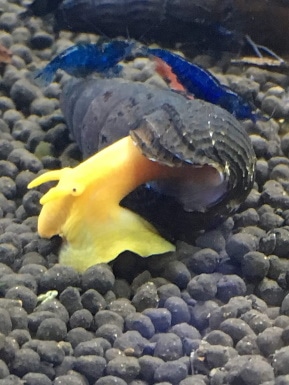
If you’re looking for a slightly more expensive snail investment, look no further than Sulawesi rabbit snails. These unique snails have a bright orange foot and a face that slightly resembles that of a rabbit. They come in a variety of types with different dark shell colors, but all have long, spiral shells. They enjoy burrowing, but they do well in gravel and other rough substrates. They love to eat algae wafers, spirulina flakes, and fresh veggies, and will eat algae growing in the tank if they decide they’re hungry enough. They are not hermaphroditic and only have one or two offspring a couple of times annually, so you won’t end up overrun with Sulawesi rabbit snails.
These snails are not guaranteed to help reduce algae in your tank and they are known to eat some live plants, especially Java ferns and other leafy green plants. They tend to be slower and less active than some other types of snails. Sulawesi rabbit snails can reach up to 5 inches in size, so they are best kept in large tanks.
Housing a goldfish isn't as simple as buying a bowl. If you're a new or experienced goldfish keeper who wants to get the setup right for your goldfish family, check out the best-selling book, The Truth About Goldfish, on Amazon. It covers all you need to know about the ideal tank setup, tank size, substrate, ornaments, plants, and so much more!
4. Nerite Snails

For the most varied and interesting shell patterns, look no further than nerite snails. These snails can have striped or spotted shells, with some even having markings that look like tire tracks. Most have smooth smells, but some varieties also have small spikes on the shell. They’re peaceful and are perfectly happy to live alone or in community tanks where the other inhabitants leave them alone. These snails are not hermaphroditic and will lay eggs in the tank, but nerite snails cannot successfully reproduce in freshwater. They require brackish water for the eggs to hatch. Nerite snails will happily eat tank algae, diatoms, algae wafers, and fresh veggies.
Breeding nerites is extremely difficult, so they’re not great candidates for breeding at home. Unfortunately, they will still lay eggs, even in freshwater, leaving the whole tank bedazzled with nerite eggs, including other snails’ shells. They’re also very sensitive to water parameters and will not thrive if nitrates are above 20ppm.
5. Cappuccino Spike/Black Devil Spike Snails
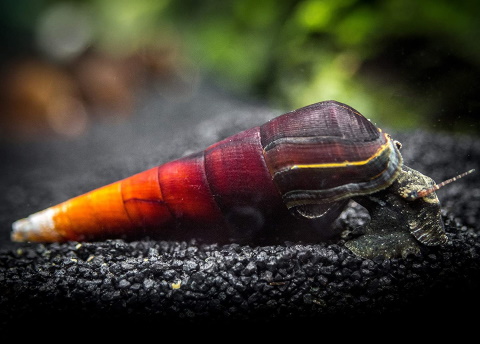
Cappuccino spike snails are a beautiful, somewhat rare variety of snail with long, pointed shells that feature gradient shades of brown and tan. When they are juveniles, they have dark brown to black shells that lighten with age. They are somewhat similar in appearance to Sulawesi rabbit snails, but they don’t get as large and they have a darker foot. Cappuccino spike snails are also fast and more active than their distant Sulawesi relatives. They’re peaceful and love to eat algae and decaying plant matter, but usually require dietary supplementation with invertebrate food, algae wafers, and fresh veggies.
Ideally, these snails should be kept in tanks with sandy substrate they can burrow in. They will not reproduce in freshwater environments and little is known about their breeding habits. They are known to sometimes eat live plants, especially tender and leafy green plants.
6. White Wizard Snails
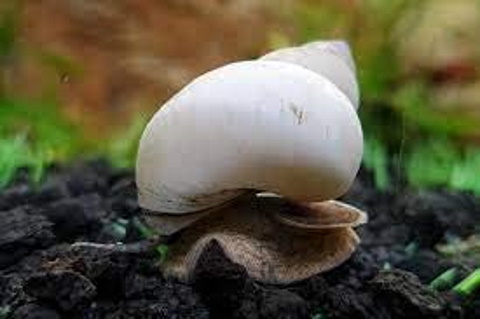
White wizard snails are also sometimes called white trapdoor snails. They are related to Japanese trapdoor snails but are prone to getting slightly larger and they are more shy. They will eat tank algae, but they’re not known to be very good at clearing algae problems. Interestingly, these snails can filter feed via their gills, which most snails cannot do, but this is not their primary form of feeding. They tend to be plant-safe and won’t eat live plants. They are not hermaphroditic and are slow to reproduce, so you shouldn’t end up with a tank overrun by them.
White wizard snails are rare, making them difficult to find, and they are usually a premium price. Their timid nature may make them a poor tank mate with especially rowdy or bully goldfish. They tend to be mostly nocturnal and may hide during the day. They should be kept in tanks with sandy substrate that allows for burrowing to prevent stress.
7. Assassin Snails
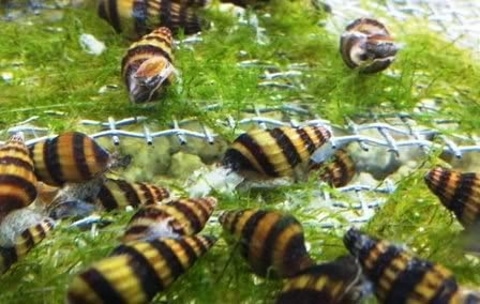
Assassin snails are interesting snails that are often “hired” for the exact job it sounds like they are; these snails are mostly carnivorous and are successful at hunting other snails and small animals, like detritus worms. Many people purchase assassin snails to help curb an overpopulation of “pest” snails. They feature an interesting shell pattern and reproduce slowly and in small numbers, so they shouldn’t replace pests in the tank with an overabundance of assassin snails. They are plant-safe and are usually safe to be kept with small invertebrates, like dwarf shrimp, if they kept are well-fed.
These snails are, obviously, not usually considered to be safe to be kept with other snails. They usually can be kept with other assassin snails and large, fast snails, like mystery snails and cappuccino spike snails, because they are opportunistic and prefer easier prey. If they’re not kept well-fed, they will turn on larger snails and will begin eating slow-moving small animals. They do not eat rotting plants or algae in the tank.
8. Ramshorn Snails
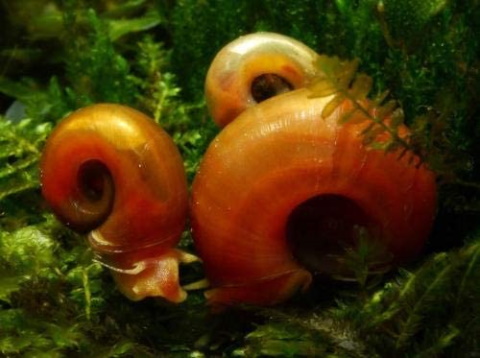
Ramshorn snails are adorable spiral-shaped snails that frequently hitchhike into tanks on live plants. They are hermaphroditic, can reproduce asexually, and will reproduce as long as there is a food source, so they are prone to taking over tanks. These snails are hardy and come in an array of colors and shell patterns. Their shells become more opaque and darken with age. There is a miniature ramshorn snail variety that usually don’t even reach ½-inch in size.
Ramshorns do not have an operculum, or the covering that many snails have that allows them to close their shell. This makes them at risk for injury from overly curious fish. They are air-breathers, so they are sometimes known to escape tanks for air, but they will dry out if they don’t find their way back to the water. These snails are a good fit for goldfish tanks because goldfish will happily snack on them, keeping the population under control. Ramshorn snails are known to eat live plants sometimes.
9. Malaysian Trumpet Snails
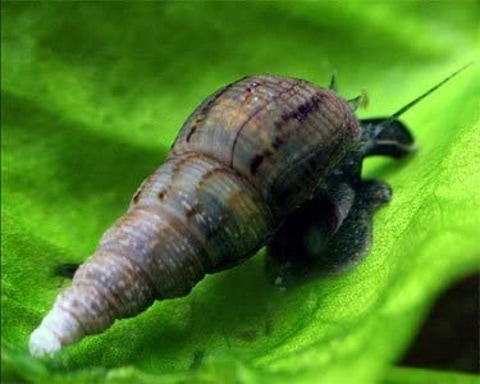
Malaysian trumpet snails have earned a reputation for being pest snails, but they can be very beneficial to tanks. They burrow and dig through the substrate, helping to keep the substrate turned and preventing gas pockets. Malaysian trumpet snails are great algae-eaters and will help clean up detritus and uneaten food. They usually do not reach a full inch in length, so goldfish are great for keeping the population under control.
These snails reproduce asexually and are live-bearers. They reproduce if there is an available food source and can quickly overtake a tank. There is little color difference among these snails, so some people find them a boring tank addition. They are frequent hitchhikers on plants.
10. Tadpole/Bladder Snails
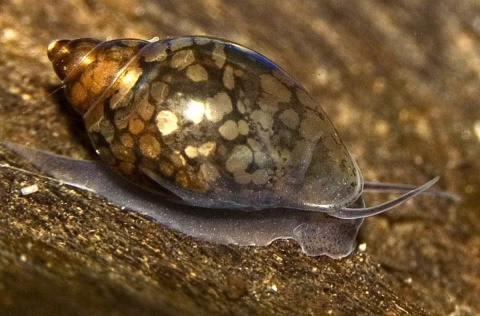
Tadpole snails are another so-called “pest” snail that reproduces asexually and can rapidly take over a tank with adequate food supply. They are frequently hitchhikers into tanks on live plants, but often are better suited for ponds due to their prolific reproductive rate. They are great at working to keep tanks clear of algae and detritus. They’re extremely hardy and can survive a large temperature range and in brackish water. This is another type of snail that is often kept under control by goldfish.
These snails are egg-layers and will leave gelatinous egg sacs in multiple locations in the tank, which many people find unattractive. These sacs can be difficult to find and remove before they hatch. Tadpole snails are known to be invasive and should not be allowed into the natural environment, so if kept in ponds, they should not be at risk for flooding or escaping into the natural environment.

Buyer’s Guide: Choosing the Best Snails to Pair With Goldfish
Tank Size
When choosing a snail for your goldfish tank, you want to choose one that will happily live in the size of tank you have. Sulawesi rabbit snails can get very long and may be uncomfortable in a small tank that doesn’t allow them plenty of space to move. Mystery snails produce a heavy bioload, so adding a mystery snail to a small tank that’s overstocked with goldfish may add too much bioload to the tank.
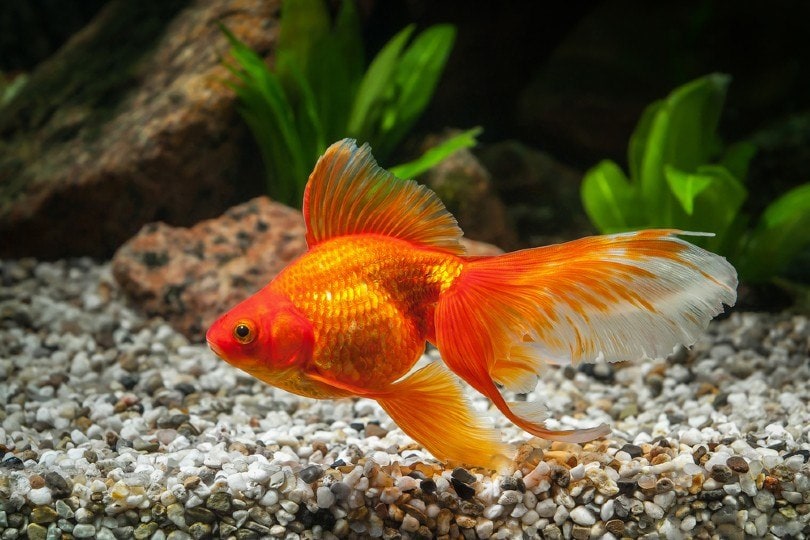
Water Parameters
Most snails prefer neutral to alkaline water, but some prefer slightly acidic pH. When keeping snails, it’s a good idea to begin monitoring your GH and KH levels to ensure the water isn’t too hard or too soft for the snails you choose. You should also choose snails that have similar water parameter and temperature preferences to goldfish.
Plants
Not all snails are plant-safe! Some snails will eat live plants no matter how well-fed they are. Some plants, like duckweed, will likely recover from being snacked on by snails, but if you keep especially delicate or rare plants, be very selective with the snails you choose. Although, if you’re keeping delicate or rare plants with goldfish, you’re already taking risks!
Breeding
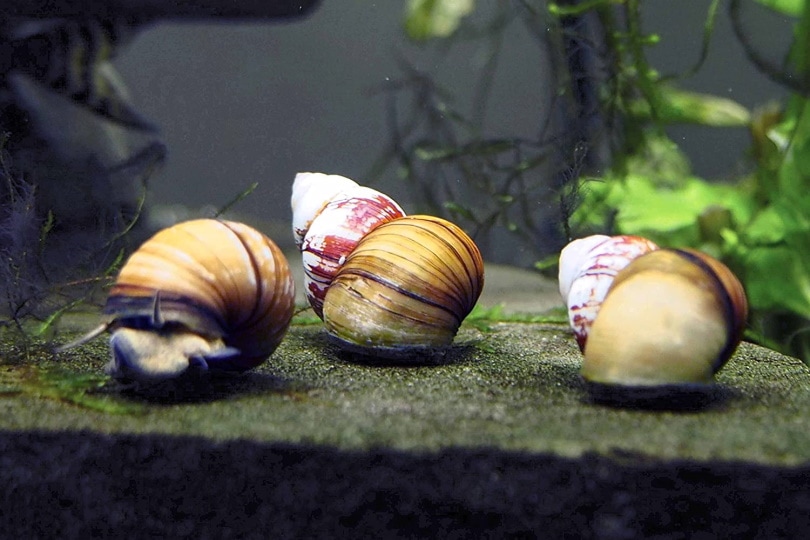
If you intend to breed the snails you choose, then you’ll need to select them with care. Goldfish will eat just about anything that fits in their mouth, which can make breeding snails difficult. If you want to breed snails that do not grow quickly, like mystery snails, then you’ll need to invest in a “grow-out” tank or breeder box that allows them to grow to a safe size before they’re out in the tank with the goldfish. Otherwise, your goldfish might eat all of your small snails before they have a chance to grow. A more heavily planted tank will increase the likelihood of survival, but you’ll need to choose the snails and plants carefully.

Final Thoughts
The best overall snails for goldfish tanks are mystery snails, with their colorful shells and fun personalities. Japanese trapdoor snails are a great pick for tight budgets and Sulawesi rabbit snails are the best premium choice when it comes to snails in goldfish tanks. These reviews cover the 10 best snails to pair with goldfish, but this isn’t an inclusive list of all freshwater snails in the aquatics trade. This is a great starting point for you to work your way out from to find the perfect snails to pair with your goldfish.
